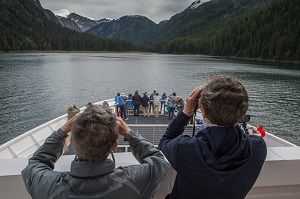We awoke to another glorious day of sunshine, having crossed the border during the night and found ourselves in Revillagigedo Channel in Southeast Alaska. Revillagigedo is one of the last places on a northward bound journey possessing a Spanish name. The heritage comes from Spanish explorers of the Pacific Northwest from the late 1700s. The new Viceroy of Mexico was Juan Vincente de Guemes Pacheco de Padilla Horcasitas y Aguayo, Conde de Revillagigedo, and many places were named after him throughout the west coast.
The Tlingit Nation has inhabited this land for thousands of years. We had to wait for customs to board the boat, as we had just left Canada. And while we were waiting to be cleared, we witnessed five humpback whales in the area. Throughout the morning, they proceeded only to come closer and closer from miles away. They finally came within photography range. Numerous flocks of common loons flew by, with their large black and white bodies close to the water.
Being cleared, we kept in the area to watch the humpbacks for a little while more. It was finally time to leave so that we could venture up into Misty Fjords. As we left the humpback whales behind, we looked out and there were four black dorsal fins. Then there was another group of dorsal fins, and another! We were surrounded by families of resident fish-eating killer whales. There were about twenty killer whales, and in every seeming direction.
We were able to identify one marked by a collapsed dorsal fin: B10, a male born in 1987. His brother was born in 1997, and his mother in 1949. We were able to spend an hour with the killer whales and the pods of Dall’s porpoise interspersed among them. They were speeding along and leaving rooster tail wakes as they went. These porpoises that are sometimes mistaken for baby killer whales (black and white markings) can reach speeds of up to 35 miles an hour.
17,000 years ago, this area was all ice, under a mile thick in some places. Carved by glaciers, the basalt walls reach up in sheer cliffs over 3,400 feet tall and then descend into the water at depths of 1,000 feet. Here mountain goats live up in the rocky reaches, and brown and black bears forage at the water’s edge. We spotted a mountain goat up on its granite perch 2,000 feet up a vertical cliff. Below the cliffs, the landscape is dominated by western hemlock, Sitka spruce, and western red cedar.
Continuing up Behm Canal, we turned into beautiful Walker Cove, complete with a brown bear. The cove had a wide rocky beach ideal to foraging bears. We spent an hour watching it turn over rocks, with the crows hopping about impatiently waiting for a free meal and sticking their beaks up close. A bald eagle waited patiently by the tideline. The bear dug around for the better part of the afternoon, seeming perfectly oblivious to the presence of birds and the distant ship of wildlife enthusiasts.
A perfect day for our first day in Southeast Alaska!









